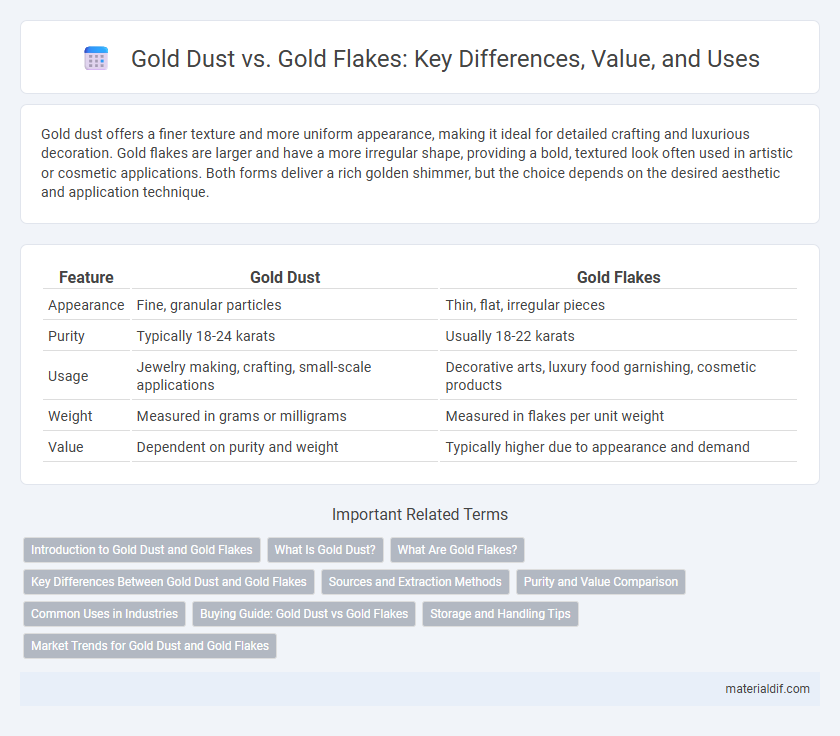Gold dust offers a finer texture and more uniform appearance, making it ideal for detailed crafting and luxurious decoration. Gold flakes are larger and have a more irregular shape, providing a bold, textured look often used in artistic or cosmetic applications. Both forms deliver a rich golden shimmer, but the choice depends on the desired aesthetic and application technique.
Table of Comparison
| Feature | Gold Dust | Gold Flakes |
|---|---|---|
| Appearance | Fine, granular particles | Thin, flat, irregular pieces |
| Purity | Typically 18-24 karats | Usually 18-22 karats |
| Usage | Jewelry making, crafting, small-scale applications | Decorative arts, luxury food garnishing, cosmetic products |
| Weight | Measured in grams or milligrams | Measured in flakes per unit weight |
| Value | Dependent on purity and weight | Typically higher due to appearance and demand |
Introduction to Gold Dust and Gold Flakes
Gold dust consists of finely granulated particles of pure gold, often found naturally in placer deposits or produced through refining processes, prized for its high purity and ease of handling in small quantities. Gold flakes are larger, flat pieces of gold that retain a delicate, flaky texture, commonly used in decorative applications and artistic designs due to their visually appealing, reflective surfaces. Both forms serve distinct purposes in industries like jewelry making, electronics, and collectibles, with gold dust favored for precision applications and gold flakes valued for their aesthetic qualities.
What Is Gold Dust?
Gold dust refers to very fine particles of gold that are smaller and less uniform than gold flakes, often found naturally in riverbeds and mining residues. It possesses a higher surface area relative to its volume, making it easier to handle and process in jewelry and industrial applications. Unlike gold flakes, which are thin, flat, and irregular, gold dust is more granular and can contain impurities depending on its source.
What Are Gold Flakes?
Gold flakes are thin, flat pieces of gold typically measuring between 0.1 to 0.5 millimeters in diameter, often used for decorative purposes in art, cosmetics, and culinary applications. Unlike gold dust, which consists of tiny, irregularly shaped particles, gold flakes have a uniform, sheet-like structure that reflects light more effectively, giving them a lustrous appearance. The purity of gold flakes usually ranges from 22K to 24K, making them valuable for both aesthetic and investment uses.
Key Differences Between Gold Dust and Gold Flakes
Gold dust consists of fine, granular particles of gold typically less than 1 millimeter in size, whereas gold flakes are larger, flat, and irregularly shaped pieces often measuring several millimeters across. The purity of gold dust can vary due to contamination with soil and other minerals, while gold flakes generally have higher purity and are easier to smelt for refining. In terms of applications, gold dust is commonly found in placer mining and panning, while gold flakes are favored in jewelry making and decorative arts for their visual appeal and ease of handling.
Sources and Extraction Methods
Gold dust primarily originates from placer deposits where erosion breaks down gold-rich rocks, allowing fine particles to accumulate in riverbeds and alluvial plains through natural sedimentation. Gold flakes, on the other hand, are often extracted from both placer deposits and lode deposits, where larger, flat particles are separated using mechanical methods like sluicing or panning, as well as chemical extraction techniques such as cyanidation in hard rock mining. Both forms require careful processing to maximize recovery, with gold dust typically demanding more delicate handling to prevent loss during extraction.
Purity and Value Comparison
Gold flakes often exhibit higher purity levels, typically ranging between 18K to 22K, compared to gold dust which can contain impurities and vary widely in karat value. The value of gold flakes is generally more consistent due to their uniform size and purity, whereas gold dust requires thorough refining to determine its true worth. Investors favor flakes for their standardized quality, while gold dust is preferred in certain industrial applications despite its lower purity and variable valuation.
Common Uses in Industries
Gold dust is primarily used in electronics and precision instruments due to its fine granularity and ease of application in conductive coatings and printed circuit boards. Gold flakes, larger and more uniform, find common use in decorative arts, luxury packaging, and specialty cosmetics for their aesthetic appeal and ability to create shimmering effects. Both forms serve key roles in industries where gold's conductivity, malleability, and visual properties are essential.
Buying Guide: Gold Dust vs Gold Flakes
Gold dust offers a higher purity level and is ideal for investors seeking concentrated gold content in a smaller quantity, while gold flakes provide a more visually appealing form suited for decorative or artisanal purposes. When choosing between gold dust and gold flakes, consider factors such as intended use, purity, market price per gram, and ease of storage or resale. Verify the source and authenticity through certified assays or trusted sellers to ensure value retention and avoid counterfeit products.
Storage and Handling Tips
Gold dust requires airtight containers to prevent contamination and moisture absorption, while gold flakes need delicate handling to avoid breakage due to their thin, brittle nature. Both forms should be stored in padded, labeled containers away from direct sunlight and humidity to maintain purity and prevent oxidation. Using soft brushes for cleaning and avoiding excessive handling preserves the integrity and value of gold particles.
Market Trends for Gold Dust and Gold Flakes
Gold dust and gold flakes are experiencing distinct market trends driven by consumer preferences and industrial demand. Gold dust remains favored in jewelry manufacturing and artisanal crafts due to its high purity and ease of melting, while gold flakes see increased use in luxury food products and cosmetic applications, reflecting a growing niche market. Both forms show resilient demand, but gold flakes are gaining momentum in non-traditional sectors, boosting market diversification and value.
Gold Dust vs Gold Flakes Infographic

 materialdif.com
materialdif.com